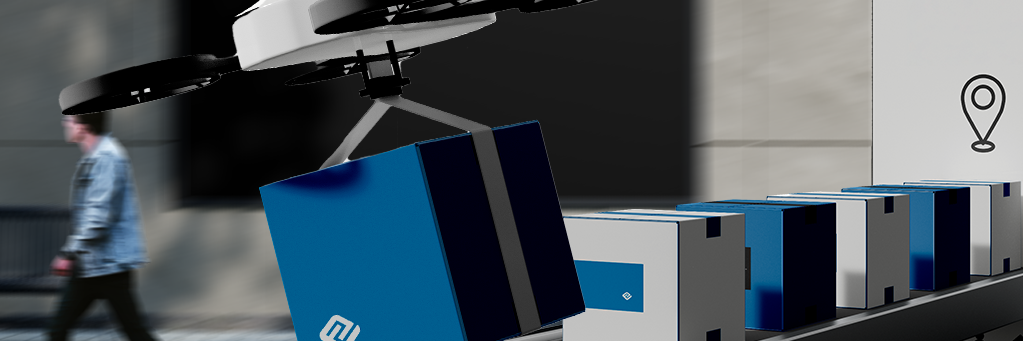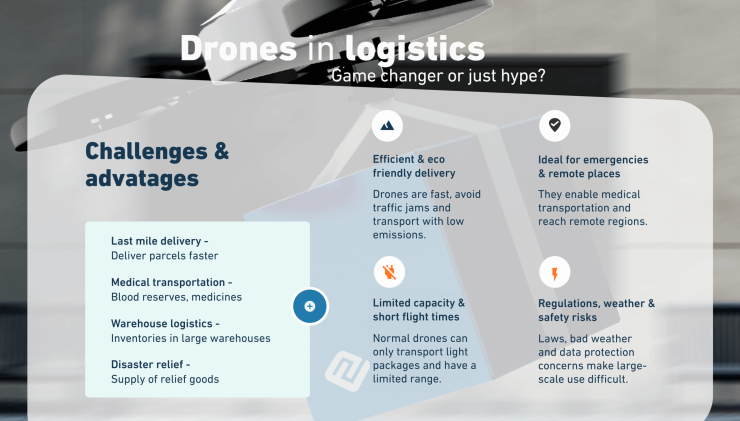As a software developer at EIKONA Logistics, he provides well thought-out and efficient solutions. His particular strength lies in his enthusiasm for technical innovations.


They are fast, quiet and relatively small: we are talking about drones. Not only are they ideal for aerial photography, they can also transport things. That makes them the ideal means of transport in logistics, especially for the last mile – right? The use of drones in logistics is currently being researched for various purposes, and in some areas they are already in use. However, there are also some hurdles. We shed light on current applications, difficulties and future potential.
The use of drones in logistics is currently being tested or has already been implemented in three main areas:
Drones equipped with cameras and scanning technology can save a lot of manpower in the warehouse by capturing barcodes and sending them to the warehouse management system. This makes inventory management much easier. Drones can also support the surveying and inspection of large facilities: No need to laboriously climb onto roofs first, since they always have the perfect overview directly from above.
The use of drones in warehouse and intralogistics is a very exciting and promising area that deserves its own article. In this article, we will therefore first focus on the use of drones in short and medium-haul transport and outline the current state of development, opportunities and challenges.
The term “last mile” has its origins in the laying of telephone cables: After the construction of local distribution points, the individual households were then connected via copper cables. The metaphorical “last mile” refers to this final section of the cable network. The image has been transferred to logistics, where the part of the transport to the customer's front door, i.e. the final section, is referred to as the last mile.
Unmanned aerial vehicle or male bee - these are the two answers you should expect when asking the question “What is a drone?”. In our case, of course, we are not referring to bees, but to unmanned flying objects. They are either operated remotely by humans or controlled by a remote or integrated computer – thus making them fully or semi-autonomous. There are various deployment areas: A distinction is commonly made between political, military, journalistic, scientific, commercial and private use.
The dream of parcel delivery by drone probably looks like this: In the morning, you realise that the present for grandma's birthday is still missing. No problem: order it online and a few hours later the drone will deliver the parcel directly to your doorstep – on time and without any stress. However, it's not quite that simple in reality.
Delivery by drone, especially on the last mile, offers many advantages: they produce significantly fewer emissions, a drone is also not stuck in traffic jams and never has to search for a parking space – unlike delivery vans. This means that urgent goods in particular can be delivered more directly.
There are two main obstacles to using transport drones for delivering parcels – but they are serious: Firstly, there is a lack of licences for use in public (air) space. Secondly, although a drone does not have to look for a parking space, it still needs a safe place to land. This is a particular problem in densely built-up city centres, as no pedestrian should be startled by a drone landing suddenly.
Time for a new scenario: once again there is a quiet whirring sound – another drone is in the air. This time it is carrying tissue samples that urgently need to be examined in the laboratory so that the oncological operation can continue. The faster the transport, the better for the patient. The pilot of the drone sits in his office, a good distance away, and controls the unmanned flying object from the comfort of his PC. An ideal scenario, isn't it?
At the moment, over 18,000 laboratory samples are transported back and forth by car between the hospital and the central laboratory every day in the Berlin area alone. In addition, around 600 special journeys are made every month for medical emergencies in which the sample has to be analysed in a specialist laboratory. Drone transport along predefined flight paths could save valuable minutes – after all, traffic jams and red traffic lights are rare in the air. The result: faster emergency response and improved patient care.
In Germany, there are several projects researching the optimal use of drones, particularly in the medical sector. Labor Berlin, Europe’s largest hospital laboratory, has been working for several years with the relevant authorities and Matternet, one of the market leaders in the field of drone logistics, on the realisation of medical drone transport. The test phase was successful, and the German Federal Aviation Office granted Labor Berlin 2023 an operating licence. This applies to an inner-city BVLOS (beyond visual line of sight) flight route over populated areas. An important milestone, but further legal approvals are still required before flight operations can begin.
The EU Drone Regulation has made the use of drones generally possible but subsequently had to be incorporated into national law. The federal states now have the option of opting out and handing over the authorisation procedure to the federal government – which means it ends up with the Federal Aviation Office. However, the waiting time for initial applications for a UAS (Unmanned Aircraft System) operating licence is currently 18 weeks, according to information from the Federal Office. That's a lot and explains why the drone business is running slowly. After all, the long waiting time is compounded by the time required to submit such an application in the correct form – not a matter of five minutes.
However, once the first operating licence has been granted, you can get started straight away. New routes throughout Europe can also be applied for quickly, thanks to the EU regulation: According to the Federal Aviation Office, a simple change application is then sufficient, which must be submitted 20 days before the planned operation.
There is also a need to catch up in terms of communication: the focus is currently on the further development of communication standards between manned and unmanned aircraft. So-called (unmanned) traffic management systems (U-TMS) provide support here: they digitally display the position of (un)manned aircraft in an aerial image.

As we all know, you shouldn't let bad weather spoil your mood, but in the case of drones, storms and ice really do have a negative impact. The UAS were developed for adverse weather conditions and can cope well with moderate rain and winds of up to 30 km/h. However, dense fog, hail and storms are a problem for the unmanned aerial vehicles.
Of course, there is also an upper limit when it comes to weight: the drones that Labor Berlin wants to use for medical transport have a capacity of four litres in the transport case and can carry two kilograms. In other areas of transport, manufacturers are simultaneously working on the development of heavy-duty drones: They can carry anything from loads in the lower three-digit kilogram range to whole tons. This in turn requires appropriate infrastructure for take-off and landing.
Will “logistics drones” soon be delivering our parcels? This is unlikely, as there is a lack of landing sites in cities and the safety requirements for authorisation in public spaces are high. Personal handovers are also a problem that has yet to be solved. Drones delivering parcels in cities is therefore expected to remain an exception in the future. These drone deliveries are more likely to be made in rural areas.
The situation looks more promising for drones as flying delivery bots in the medical sector. Car couriers who bring laboratory samples from A to B are heavily dependent on traffic, which takes valuable time. Drone transport can offer planning security and save time. This is why urban BVLOS networks are already being planned to deliver medical supplies within the EU by drone. Another advantage is that such an air transport network can cover and connect many locations. This means there are no additional costs for setting up widely dispersed laboratory infrastructures, while medical care becomes much more efficient.
Generally speaking, logistics and drones go well together. In another article, we therefore take a closer look at the use of drones in warehouse and intralogistics. It's worth sticking around!